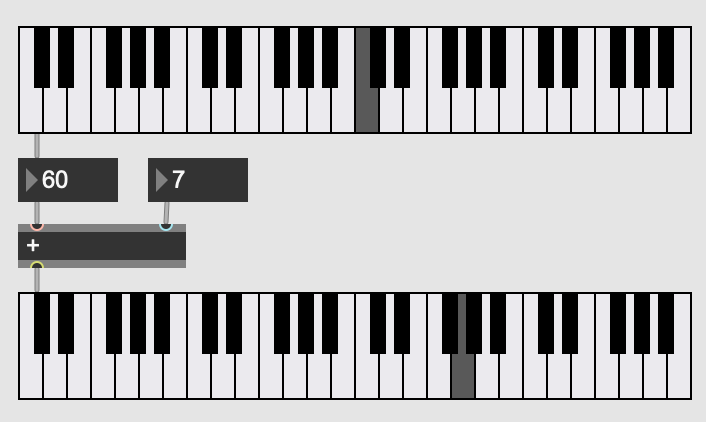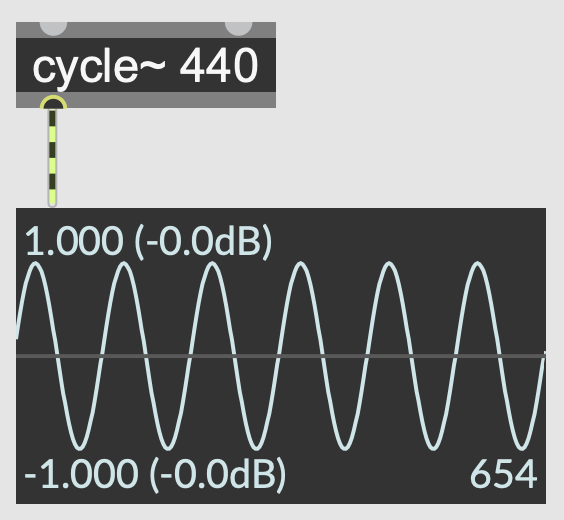An introduction to Max/MSP
The Max/MSP ecosystem
Max/MSP is a visual programming language and environment for music and multimedia, owned by the company Cycling ‘74. Max/MSP is a commercial product, and not an open source project.
Max/MSP has a thirty-year history, began in 1988 at IRCAM in Paris thanks to Miller Puckette. Some notes on its history can be found on the dedicated wikipedia page.
The Max/MSP ecosystem includes a visual programming environment (the Patcher Window) and a large number of routines (called objects). An object can be seen as a function that processes input data to generate output data. These objects are created (as visual objects) in the Patcher Window and connected together with Patch cords for creating algorithms. A Max/MSP program is called a patch.
Many objects are available natively in the software itself, but the Max/MSP ecosystem can be expanded with thirdy-party libraries (collections of objects). Cycling ‘74 made available an SDK (Software Development Kit) for the community of developers with an extensive API (Application Programming Interface) for building external objects in C/C++.
There is a large user base of programmers, unaffiliated with Cycling ‘74, who enhance the Max/MSP environment with commercial and non-commercial extensions and libraries.
The main sections that compose the native Max/MSP ecosystem are: Max, MSP, Jitter, Gen, Node.
Max section
The Max section covers all the concepts connected to the processing of control data streams, managing all data that are not audio signals or image matrices. The signals handled by this section are called control signals. The objects (functions) that act on these signals are connected to each other with gray patch chords (by default).

The control signals in Max/MSP can be of the following data types:
- Integer Numbers: positive and negative integer numbers. Integer type is indicated by the letter i.
- Float Number: real numbers, with 32bit precision. Float is indicated by the letter f.
- Symbols: alphanumeric string. Symbol is indicated with the letter s (or sym in some cases).
- Lists: a list of symbols or numbers. List is indicated by the letter l.
MSP section
The MSP section covers all the concepts connected to the processing of audio data streams (audio signals). An audio signal is a Float number (32bit precision). In the Max/MSP environment audio signals can be passed and transmitted between objects only if the DSP (audio processing) is enabled, unlike control signals, which are always active. The objects (functions) that act on these signals always have a name ending with a tilde symbols (~) and they are connected to each other with a segmented patch chords (yellow and black by default).

An audio signal is a discrete time function (defined by samples at the rate of the sampling frequency: the Sample Rate) and can be used to represent both waveforms and any other time-varying numerical parameter, as well as constants.
Jitter section
The Jitter section covers all the concepts connected to the image/video/3D processing. The data type used in this section is the jitter matrix. A matrix is a grid, with each location in the grid containing some information. The value in each cell of the matrix can be stored in various ways: char, long, float32, or float64. In Jitter, a matrix can have any number of dimensions from 1 to 32. Each matrix has also a specific number of planes, which represents the amount of values that can be written in a cell. A one-dimensional matrix is comparable to a normal Array.
A black and white image is a typical two-dimensional one-plane matrix, where each cell represents the grayscale value to be associated with that pixel.

The objects (functions) that act on matrixes always have a name starting with the prefix .jit and they are connected to each other with a segmented patch chords (green and black by default).
Gen section
This section is an extension of the Max patching environment that converts what you build visually into efficient compiled code.
Nodes section
This section is an extension that allows the integration of the nodeJS environment into the Max/MSP environment.
The Max/MSP visual programming environment
- concept of patch
- patcher window
- connecting objects
The anatomy of a Max/MSP Object
- concept of inlets and outlets
- hot and cold inlets
Max Object
MSP Object “~”
- riceive two types of
Connections (patch cords)
Audio Signal
Control signal
Data Type of control signal
Using libraries
- citare alcune librerie famose